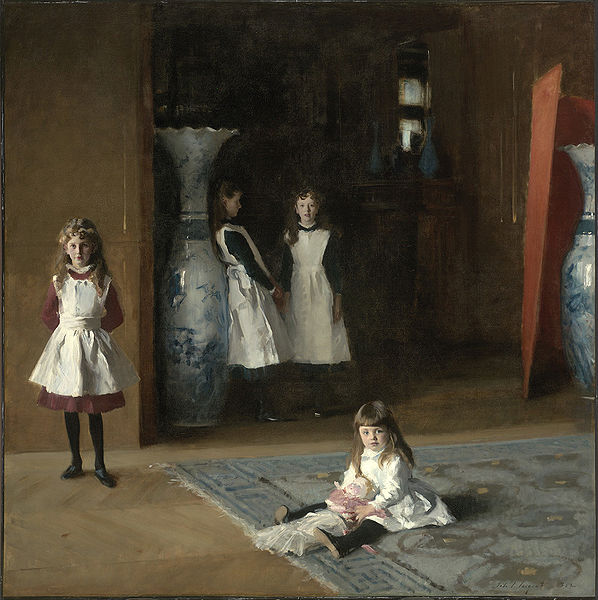One of my favorite American painters, only two of the selections featured below are my own photos.The others are culled from various sources on the 'net and represent paintings I've actually seen up-close and personal at their respective permanent museums. I felt really lucky when I realized this! :-)
Carnation, Lily, Lily, Rose
1887
Fumee d'ambre gris (Smoke of Ambergris)
1880
Williamstown, Massachusetts, USA
Madame X
(Virginie Avegno Gautreau)
1884
The Daughters of Edward Darley Boit
1882
Boston Museum of Fine Arts
Pagan Sphinx Photo 2010 © All Rights Reserved
Note:The large, grand vases portrayed in the painting above are also displayed in the same room and I was able to photograph them. I also photographed the painting below. Unlike my attempts to photograph the portrait of the two little girls playing, this one below didn't give me nearly as much trouble.
Pagan Sphinx Photo 2010 © All Rights Reserved
Pagan Sphinx Photo 2010 © All Rights Reserved
Mrs. Fiske Warren and her daughter Rachel
1903





















Madame X's face is magnificent: what a mixture of arrogance, fragility, hardness, beauty and dubious experience!
ReplyDeleteI have never seen these particular paintings, but having just read 'The Age of Innocence' they seem to epitomise an era that brought change to society. They are truly beautiful; the first two, ephemeral.
ReplyDeleteBeautiful, and those not yours too.
ReplyDeleteI agree, Sargent was a master. When I see his work I find it hard to tear myself away.
ReplyDeleteThese are all beautiful, but the first one is conceptually brilliant to a degree which I, with my limited knowledge of art, find breathtaking!
ReplyDeleteOne of my all time favorite paintings is 'Fumee d'ambre gris (Smoke of Ambergris)'. His work was extraordinary.
ReplyDeleteThere are a number of artists who lose a LOT between the originals and reproductions or photos. Monet's paintings become solid things in reproductions, but in "person" they look like they could blow away or like they glow and will gradually dim as the afternoon wears on. You almost feel like cloud shadows should pass over them at any moment. Rubens' blues are simply not believable until you see them in person, and his figures are so weighty that they look like the frames can't hold them. The massive carved pieces used to surround his work in most museums look too heavy on anyone else - but never on him. Frieseke and Sargent look like many other late 19th century and early twentieth century painters until you see the originals. Then, you stand a distance away and they are the most real things in the room - more real than other viewers standing around you - more real than you are yourself. As you walk forward they disappear into the must lush and flamboyant use of paint possible while still capturing reality as powerfully as they do. Their touches are quite different - Sargent so masculine and powerful in his strokes, while Frieseke's paintings almost look like cakes, like icing, edible, succulent, sweet, fruity. Both are intoxicating. I've spent long minutes walking back and forth across galleries, watching for the precise moment when they transition from people to paint, from feminine garments and curves to confection.
ReplyDeleteThanks for sharing these!
Oh - and Sargent's watercolors are another kind of amazing. Dear Cunning Runt - since you love the conceptual and compositional brilliance of the first piece in this post you should look into his watercolors, where he regularly plays this masterful game with absence and presence. The man clearly did not see the way the rest of us do.
ReplyDelete